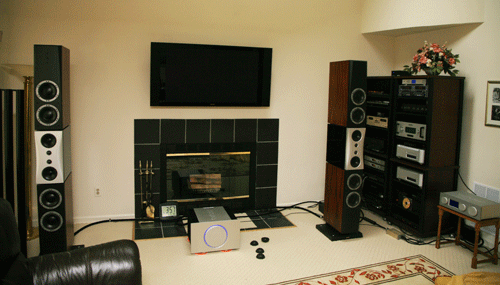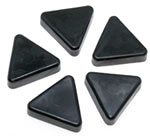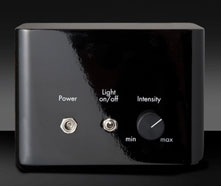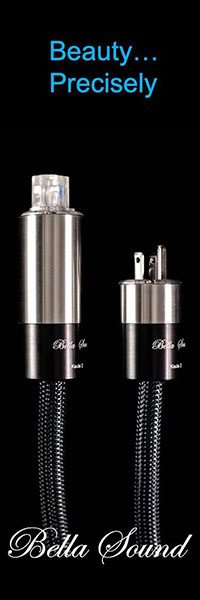The Steinmusic Harmonizers
|
The Steinmusic Harmonizers
|
 I was absolutely delighted recently, to find it was now possible to make truly significant improvements to ones high-end system without having to swap out a single component! I was absolutely delighted recently, to find it was now possible to make truly significant improvements to ones high-end system without having to swap out a single component!
I’d describe myself as a confirmed skeptic whose open mind is not as wide as some. Actually, I’d consider mine to be only slightly ajar. My first inclination to anyone claiming a “better mousetrap,” is for them to prove it and let the chips fall where they may. I can attest there are many ways to enhance the musicality of our beloved systems but all tweaks are not equal. Manufacturers and users of tweaks often claim fantastic sound improvements to a system. During my fifty years of enjoying great sound and music, I have to admit to taking the bait at times, i.e. getting the latest products from Bybee, a set of Argent Room Lenses and an assortment of other gizmos, including expensive AC conditioners and power cords. I too, experienced varying degrees of success along the way, but I’ll admit to having always enjoyed the inexpensive tweaks the most (yeah, enhance the sound but leave my wallet intact!). The heart of my reference audio system consists of the reference Behold BPA768 [replete with room correction and CD transport], the Nova Physics Memory Player – replacing my former $40k Esoteric transport/DAC combo, Dynaudio Temptation loudspeakers, and Bybee power conditioning and cabling throughout. My room is 15 feet wide by 25 feet deep with a vaulted 15-foot ceiling. I am thrilled with the performance my system provides. In respect to tweaks, I usually don’t go looking for the next best thing, but if something conveniently presents itself, I am open to investigating its merits. My good friend, Clement Perry (CP) at Stereo Times, who I like to call “the man with golden ears,” phoned me a few months ago to say he was extremely excited about a new tweak product he had just reviewed. He explained that it was a system consisting of three, small black boxes called Steinmusic Harmonizers. When I questioned CP on how the Harmonizers worked he explained (as best he could) that the Harmonizers, “…energize the room’s air molecules, placing them in a kinetic motion. This effect translates into an improvement in what one hears from their system,” said CP. Needless to say, I can’t print my response to this explanation. Let me just add though that I told him I needed to be convinced in my own room with my equipment. The Harmonizers are not anything close to affordable. At about $1k a pop for each box, I think they’re hellishly expensive, even for what they claim to do. CP got started by simply placing two “A” Harmonizers behind the loudspeakers and a single “B” Harmonizer in another corner behind my listening seat. I then proceeded to play some familiar, well-recorded music tracks, sat back in my sweet spot and began to listen. I was immediately taken aback by the transformation of sound that began as soon as the music started up, but thought it was my imagination. So then I listened to another song, then another. The sensation that something special was occuring never went away. First, there was an enormous increase in the size and layering of the sound coming from around, in front of, and behind my loudspeakers. The Harmonizers created an even better holographic effect on the soundstage compared to what I formally had. There was much more of a “wall of sound” sensation to the music. Image specificity was so dead on, my loudspeakers seemed to be merely incidental and had nothing to do with the source from where the music had emerged. The music sounded even more natural and tonally authentic. No undesirable artifacts were introduced whatsoever. My room was transformed into something completely different: a higher plane of reality was achieved. It was as if the walls moved back and the room got larger. I heard spatial cues along with macro/micro dynamics that placed me much closer to the original recording’s venue, rather than my listening space. The effect that these Harmonizers created allowed me to have a clearer picture into the recording engineer’s style and technique. The better the recording the more pronounced the layering and depth were. To date, my system sounded extremely satisfying for my tastes prior to the introduction of the Harmonizers. Personally, I would have never believed this level of improvement was possible to experience here in my own living space. CP didn’t have to ask me what I thought. He could easily read my reactions as he chuckled sitting off to the side. When I did decide to voice my satisfaction, all I said was, “I now understand your enthusiasm about the Harmonizers.” CP certainly hit a grand slam by recommending this product. Hearing is believing. For those of you who readily dismiss this kind of stuff, all I can say is have a nice day and continue what you’re doing. But if you too keep your open-mindedness door slightly ajar, you deserve to give the Harmonizers a trial run in your system. The thing I find myself doing the most since the Steinmusic Harmonizers have made their way into my home is sit back and enjoy my vast music collection like never before. Oops, there goes my phone again… Might be CP with another one of these tweaks.
Take Two: Life with the Steinmusic Harmonizers
I’m aware that most audiophiles are, justifiably, skeptical of any piece of gear or equipment that is touted as a game-changer, but, as you will see, that is exactly what has happened for me and would likely happen for you also should you elect to give this product a try. Since I am probably unfamiliar to almost everyone reading this, here is some brief background on yours truly. I have been an audiophile since the late 1960s and have gone through a myriad of loudspeakers, amplifiers, pre-amps, cables, etc. etc. over the past 40+ years. I have owned a number of reference-quality products including the Dynaudio Evidence Master loudspeakers, Mark Levinson Reference No. 32 preamp, Mark Levinson Reference No. 33 amplifiers, Transparent Audio Reference MM interconnects, Opus speaker cables, and so on. Like most high-end junkies, I had been on an unending quest for “perfect” sound, which, inevitably leads to honorary membership in the ‘component-of-the-month’ club. In recent years, the fever had somewhat abated and, for some time now, I had been living quite happily with the following system that includes the Focal Nova Utopia Be loudspeakers, Mark Levinson No. 33 amplifiers, VTL 7.5 preamplifier, Mark Levinon 31.5/30.6 transport/DAC combo using Transparent Reference MM. My modest analog rig includes the VPI Aires turntable, JMR arm, and Benz Micro Ruby II cartridge. There’s an assortment of tweaks that adorn my listening space too. Up until now, I’ve always felt I had an excellent sounding system. What I have recently achieved, however, is an even greater illusion of being in attendance at a live musical performance. These performances range from great to astonishing depending on the quality/excellence of the specific recording/engineering. It is worth repeating this point – for the first time in over 40 years, I don’t feel I’m listening to good sound coming out of a system, rather, I’m listening to a performance closer to the original recording space (the system is really “not there” at all). In fact, it appears somewhat irrelevant to the illusion of this live performance! This illusion, by the way, is something so unshakeable, that a number of audiophile friends have been literally shocked by its power. It is not subtle, and is quite apparent to golden ears and casual listeners alike (my spouse for one – lol). Any comments that I, or others, might have about sound these days tend to be about recording and/or site criteria, i.e. close vs. distant microphone placement, large vs. small hall, etc. Frankly, I never knew that this level of involvement /performance was possible in my home.
Let me get right to the bottom line first. I am so flabbergasted by what the Harmonizers do that I can’t imagine any system – no matter how good – that would not be significantly improved by them. The good news is that this is extremely simple to do, just buy ‘em, plug ‘em in and listen. The bad news – they aren’t cheap. That said, I do not know of, or have experienced another passively-based tweak with this level of improvement regardless of cost. In that sense, the Harmonizers are probably the most impressive tweak I have ever purchased. At this point, you must be wondering what these things actually DO. Well, honestly, the science is beyond my ability to truly understand and/or explain, so, I’m not even going to try. All I can say is that the results are REAL. While the Harmonizers don’t produce a sound of their own (no sound at all, in fact), they allow you to hear your system in an entirely new way. To try and capture in words, how this actually “sounds,” let me create this imaginary, hypothetical scenario: say you have an otherwise excellent system which is being constrained by a low-power solid-state stereo amp. Imagine, then, substituting world-class tube mono amps with 1,000 watts per side. What are the changes you would likely hear? If you said tremendous increases in: soundstage air and bloom; effortless dynamics; holographic and palpable imaging; transparency, etc., as well as somehow allowing individual instruments to sound MORE individual and ‘like’ themselves, you would be right – and you would also be describing what the Harmonizers did in my already excellent system. These Harmonizers literally created a new paradigm in what was possible in my listening room. By the way, I am using two “A” and two “B” Harmonizers, as well as ten Magic Stones in my room. Your requirements may be different, depending on room dimensions. I imagine that if you tried to summarize what the boxes do in a couple of words you might say, “spatial enhancement.” To me, this is hardly adequate. They are supposed to allow sound to actually “flow” better than it otherwise could and, thus, infuse the music with a much more relaxed “feel.” They do this and more. By allowing the entire soundstage to expand and breathe, they allow you to hear individual sounds within that soundstage with less effort. If you then clean up that huge space by using a good-quality power conditioner, the result is simply stunning and the “thereness” factor goes through the roof! I find it difficult to explain this exactly, but it seems that the more confusion you remove from the soundstage, the more ambiance and air you create. The instruments or voices that exist in this improved space now become so clear that they simply sound more real and less like electronic representations.
By the way, another plus is that this type of improvement is one that is consistent across every recording or sound that comes out of the speakers no matter what the source. Even movie dialog is more intelligible! Conclusion: If you are thinking about changing any of the components in your system, I would suggest you try and hear what these boxes do first. You may be so (pleasantly) surprised at the improvement, that you may just forego what you thought was a necessary upgrade – or at least postpone it until you can get the smile off your face!
Manufacturers info: Steinmusic Ltd. Hingbergstr, 103, D 45468 Muheim Website: http://fidelisav.com/
|
|
Don’t forget to bookmark us! (CTRL-SHFT-D)
|
Stereo Times Masthead
Publisher/Founder
Clement Perry
Editor
Dave Thomas
Senior Editors
Frank Alles, Mike Girardi, Russell Lichter, Terry London, Moreno Mitchell, Paul Szabady, Bill Wells, Mike Wright, and Stephen Yan,
Current Contributors
David Abramson, Tim Barrall, Dave Allison, Ron Cook, Lewis Dardick, John Hoffman, Dan Secula, Don Shaulis, Greg Simmons, Eric Teh, Greg Voth, Richard Willie, Ed Van Winkle, Rob Dockery, Richard Doron, and Daveed Turek
Site Management Clement Perry
Ad Designer: Martin Perry





 Did he really expect me to believe that bunch of “you know what?” My Bullsh*t antennae went on full alert. Must have been a few days later when CP arrived with three small boxes containing the Harmonizers. Two of the boxes were 4.5 inches. The Harmonizers (as we call them) came designated as “A” and “B” type boxes, respectively. An extra “A” box allows you to, “triangulate them around the listening room, thus obtaining more coverage,” says designer Holger Stein. Two is the least expensive and the most practical (for comparisons sake I asked that he bring a third box). The Harmonizers can be powered by either plugging them into an AC outlet or by way of ordinary batteries (4 AAA) when the best location may not have an AC outlet nearby (smart). CP also had with him twelve Magic Stones which are said to work in conjunction with the Harmonizers. These little triangular shaped accessories, not bigger than a piece of candy (1.5″) are supposed to be placed in the corners of your listening room to help activate the air molecules.
Did he really expect me to believe that bunch of “you know what?” My Bullsh*t antennae went on full alert. Must have been a few days later when CP arrived with three small boxes containing the Harmonizers. Two of the boxes were 4.5 inches. The Harmonizers (as we call them) came designated as “A” and “B” type boxes, respectively. An extra “A” box allows you to, “triangulate them around the listening room, thus obtaining more coverage,” says designer Holger Stein. Two is the least expensive and the most practical (for comparisons sake I asked that he bring a third box). The Harmonizers can be powered by either plugging them into an AC outlet or by way of ordinary batteries (4 AAA) when the best location may not have an AC outlet nearby (smart). CP also had with him twelve Magic Stones which are said to work in conjunction with the Harmonizers. These little triangular shaped accessories, not bigger than a piece of candy (1.5″) are supposed to be placed in the corners of your listening room to help activate the air molecules.
 While I am a long-time audiophile, it has been some time since I’ve put pen to paper to focus my thoughts on the high-end audio world. What has prompted me to do so now is to tell you, my fellow audiophiles about several products that I have used lately that have “shaken my world” as to what is possible in reproducing music in a home environment. The following review pertains to one of these products – the Steinmusic Harmonizer System.
While I am a long-time audiophile, it has been some time since I’ve put pen to paper to focus my thoughts on the high-end audio world. What has prompted me to do so now is to tell you, my fellow audiophiles about several products that I have used lately that have “shaken my world” as to what is possible in reproducing music in a home environment. The following review pertains to one of these products – the Steinmusic Harmonizer System. So, how have I achieved this level of performance? Basically, through significant improvements in two major areas: (1) acoustic treatment and room correction, and (2) “tweaks” of various types. Again, the following commentary pertains only to the Steinmusic Harmonizers (Harmonizers for short). I intend to discuss room correction and other tweaks in a subsequent article hopefully sooner than later.
So, how have I achieved this level of performance? Basically, through significant improvements in two major areas: (1) acoustic treatment and room correction, and (2) “tweaks” of various types. Again, the following commentary pertains only to the Steinmusic Harmonizers (Harmonizers for short). I intend to discuss room correction and other tweaks in a subsequent article hopefully sooner than later. Let me attempt to describe these changes in terms of the music itself. Take, for example, one of my favorite jazz discs, Clark Terry’sLive At The Village Gate [Chesky JD49]. This is a live recording whose first track, “Top & Bottom,” opens with someone announcing, “Ladies and Gentlemen, Mr. Clark Terry.” The instant I heard that announcement I knew this was going to be good. The sense of being in that room with the audience was much greater than ever before – you could really hear the room. When the band kicked in, it was as if I had been transported back in time to the original event. The palpability of the instruments themselves – Clark Terry’s trumpet, Jimmy Heath’s sax, Kenny Washington’s drum kit, etc. – was amazing, with each musician clearly occupying his own space within the context of the room, and, as noted, these boxes allow you to hear their instruments in a way that makes them sound richer and more like the real thing. On track 2, “Keep, Keep, Keep On Keepin’ On,” the crowd joins in singing with Terry during an intro to the tune. Once again, the sense of being “in” that crowd is so strong that you just want to join in and sing with them! As a professional drummer, I am also particularly sensitive to the sound of recorded cymbals, so another aspect of how the sound changed was most intriguing to me. While Washington’s cymbals became cleaner, clearer and more discernable, they also took on a more delicate sound in the sense of less unnatural sizzle being replaced by a more natural shimmer and fuller-bodied overtones.
Let me attempt to describe these changes in terms of the music itself. Take, for example, one of my favorite jazz discs, Clark Terry’sLive At The Village Gate [Chesky JD49]. This is a live recording whose first track, “Top & Bottom,” opens with someone announcing, “Ladies and Gentlemen, Mr. Clark Terry.” The instant I heard that announcement I knew this was going to be good. The sense of being in that room with the audience was much greater than ever before – you could really hear the room. When the band kicked in, it was as if I had been transported back in time to the original event. The palpability of the instruments themselves – Clark Terry’s trumpet, Jimmy Heath’s sax, Kenny Washington’s drum kit, etc. – was amazing, with each musician clearly occupying his own space within the context of the room, and, as noted, these boxes allow you to hear their instruments in a way that makes them sound richer and more like the real thing. On track 2, “Keep, Keep, Keep On Keepin’ On,” the crowd joins in singing with Terry during an intro to the tune. Once again, the sense of being “in” that crowd is so strong that you just want to join in and sing with them! As a professional drummer, I am also particularly sensitive to the sound of recorded cymbals, so another aspect of how the sound changed was most intriguing to me. While Washington’s cymbals became cleaner, clearer and more discernable, they also took on a more delicate sound in the sense of less unnatural sizzle being replaced by a more natural shimmer and fuller-bodied overtones. This phenomenon occurs with vocalists as well. Voices are much more lifelike and present and take on a more relaxed naturalness. This sensation of presence and of a being at an event is so strong that it caused my wife to comment on it (and that is a BIG deal, believe me). She has listened to the many iterations of my system over the years and, while appreciating the sound, has rarely commented on it. She is a music-lover, not an audiophile, but, she can really hear with the best of them. She was recently listening to Sinatra’s recording of “What’s New” from his CD Frank Sinatra Sings For Only The Lonely [Capitol CD CDP7484712]. When the song ended she turned to me and said “I feel like I want to walk up to him and ask for his autograph.” I couldn’t have said it better.
This phenomenon occurs with vocalists as well. Voices are much more lifelike and present and take on a more relaxed naturalness. This sensation of presence and of a being at an event is so strong that it caused my wife to comment on it (and that is a BIG deal, believe me). She has listened to the many iterations of my system over the years and, while appreciating the sound, has rarely commented on it. She is a music-lover, not an audiophile, but, she can really hear with the best of them. She was recently listening to Sinatra’s recording of “What’s New” from his CD Frank Sinatra Sings For Only The Lonely [Capitol CD CDP7484712]. When the song ended she turned to me and said “I feel like I want to walk up to him and ask for his autograph.” I couldn’t have said it better.



Be the first to comment on: The Steinmusic Harmonizers